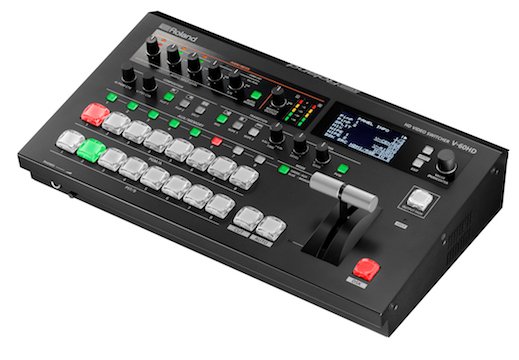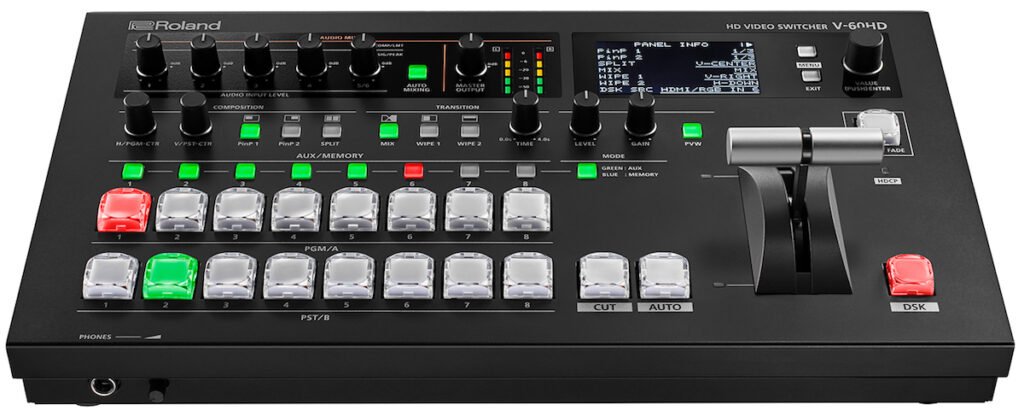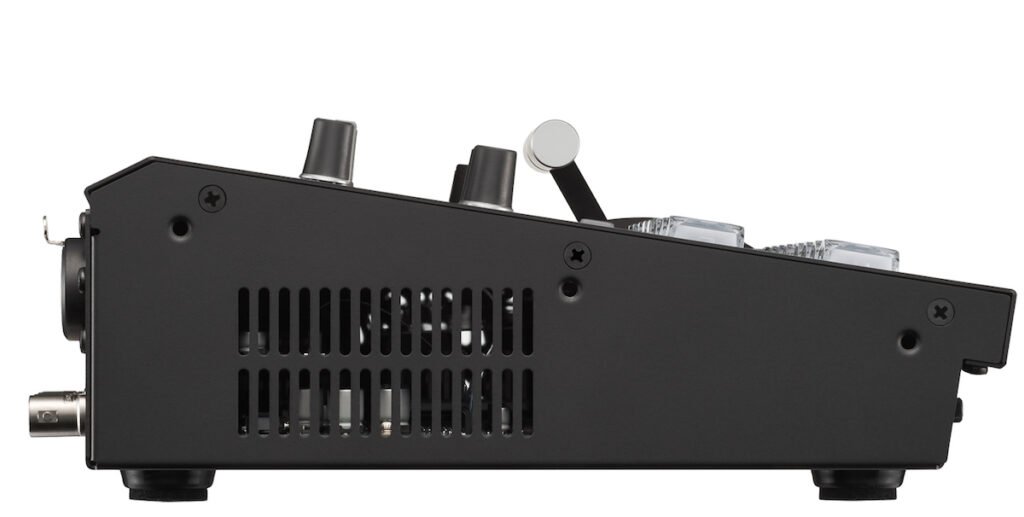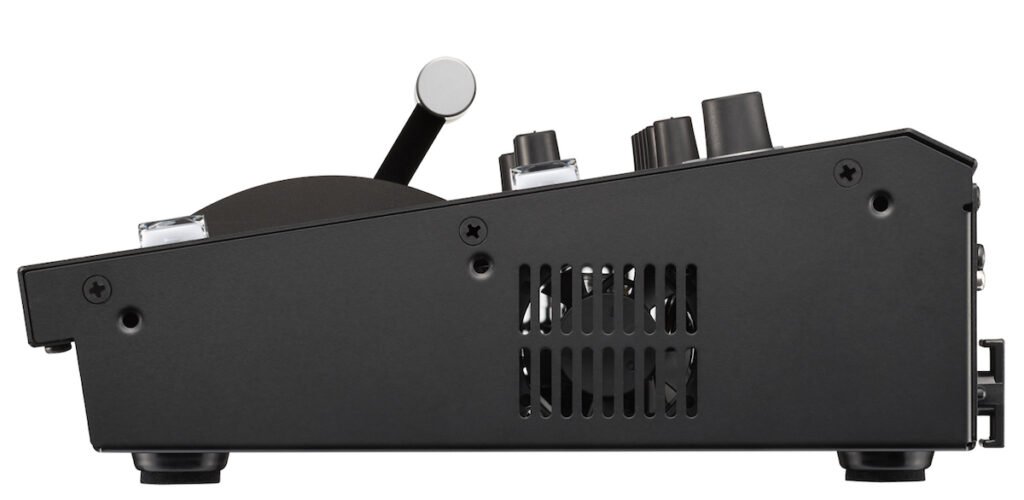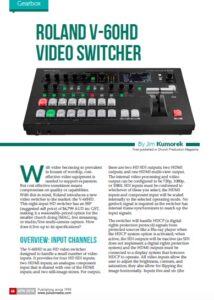Subscribe to CX E-News
GEARBOX
Roland V-60HD Video Switcher
By Jim Kumorek
First published in Church Production Magazine.
With video becoming so prevalent in houses of worship, cost-effective video equipment is needed to support expansion. But cost effective sometimes means compromises on quality or capabilities. With this in mind, Roland introduces a new video switcher to the market: the V-60HD.
This eight-input HD switcher has an SSP (suggested sell price) of $4,799 AUD inc GST, making it a reasonably-priced option for the smaller church doing IMAG, live streaming, or studio/live multi-camera capture. How does it live up to its specifications?
Overview: Input Channels
The V-60HD is an HD video switcher designed to handle a small number of video inputs. It provides for four HD SDI inputs; two HDMI inputs; an analogue component input that is shared with one of the HDMI inputs; and two still-image stores. For output, there are two HD SDI outputs; two HDMI outputs; and one HDMI multi-view output.
The internal video processing and video output can be configured to be 720p, 1080p, or 1080i. SDI inputs must be conformed to whichever of these you select; the HDMI inputs and component input will be scaled internally to the selected operating mode. No genlock signal is required as the switcher has internal frame synchronizers to match up the input signals.
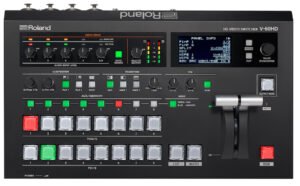 The switcher will handle HDCP (a digital rights protection protocol) signals from protected sources like a Blu-ray player when the HDCP system option is activated; when active, the SDI outputs will be inactive (as SDI does not implement a digital rights protection system) and the HDMI outputs must be connected to a display system that honours HDCP to operate.
The switcher will handle HDCP (a digital rights protection protocol) signals from protected sources like a Blu-ray player when the HDCP system option is activated; when active, the SDI outputs will be inactive (as SDI does not implement a digital rights protection system) and the HDMI outputs must be connected to a display system that honours HDCP to operate.
All video inputs allow the user to adjust the brightness, contrast, and saturation; they also allow for flipping the image horizontally.
Inputs five and six (the HDMI/component inputs) additionally allow for custom scaling and adjustments to the red, green, and blue channels. In addition to the video inputs and outputs, the V-60HD has an audio mixer built into it, enabling you to combine embedded digital audio from the six video inputs with six analogue audio input jacks.
Physical level knobs are provided for the analogue inputs; the digital inputs can be adjusted via the menu system. The switcher also lets you embed specific audio sources into the SDI outputs to create a multi-track audio transmission. This would enable you to do things like add the pastor’s mic as a separate channel to a video overflow room in addition to the two-track mix to give the destination more control over the audio mix.
Compositing
The V-60HD provides several compositing features. Of highest interest to a house of worship would be the down-stream keyer, or DSK. The DSK enables you to take one input, typically from a computer running presentation software like ProPresenter or EasyWorship, apply luma or chroma keying to the source to turn the background of a graphic transparent and superimpose it on the video output.
The keyer can be set to remove blue, green, black, or white, with controls to set the tolerances for the colour it is to key. This is how you get your lower third graphics, such as bible verse, or song lyrics, over your live video. The name DSK indicates that it occurs down-stream of any other compositing and processing options you choose, such as those described next.
The switcher supports two picture-in-picture preset buttons, each with its own configurable size, position, shape and border parameters. You can also composite two inputs into a split-screen configuration.
Outputs
The four video outputs of the switcher can be assigned to any of the three output functions of the switcher: program out, preview out, or aux out. Program out is the “live” output of the switcher and is selected by the upper row of “crosspoint” buttons; preview out is the input channel loaded into the preview bus via the lower row of crosspoint buttons; and aux is a separate video output that is switched using the smaller buttons above the program row of crosspoint buttons.
Switching Controls
There are several controls for initiating a switch to a different input. Besides pressing a program crosspoint button directly, you can activate a control that transitions the preview crosspoint over to the program crosspoint. The cut button makes an instantaneous switch; the auto button uses the selected transition (mix, wipe one or wipe two) to perform the transition in the length of time selected by a rotary control on the panel.
Menu
Lastly, there’s also an LCD display panel which shows the current status of the switcher as well as giving access to the system menus for configuration. A rotary knob with integrated push-button function lets you navigate the menus and make changes.
Impressions
On unboxing, I found the switcher feels very solid and well-constructed. All controls have a quality feel to them. Based on my time spent with the V-60HD, I would expect the switcher to withstand the demands of a typical church quite well.
Setup was very easy. All connection points are easily accessed and clear to their function. I was able to set up the switcher and start using it without using the user manual. Once I got into using the still image store system, I admit I needed to break out the manual. But even the DSK module was pretty self-explanatory — at least for someone with a bit of video production experience.
The outputs looked great, both HD-SDI as well as HDMI. The multi-viewer screen presented all inputs and the preview/program outputs in an easy to see format. The menus were reasonably clear, but perhaps a little bit clunky. However, once you’re set up and have picked your operating modes, loaded your graphics, etc., you probably won’t be in the menus a lot.
In the menus, it would be helpful if some sort of indicator was present to show that there’s another page you can navigate to. I completely missed the settings in the menus for the audio signals embedded with the video input signals because I didn’t realize there were more menu pages—the last analogue audio setting page seemed like the last page to me.
I spent several hours working with the V-60HD, trying different input sources, and working with the down-stream keyer. Operation was for the most part easy and smooth.
The wipes (as opposed to the basic mix/crossfade) felt a little bit jerky, but I imagine no one other than someone working on video would notice. There are “soft” versions of all the transition options, which feather the edge—this provides a “motion blur” type look and does not feel at all jerky.
It took me a while to figure out how to control the volume of the embedded audio in the HDMI signal from the Blu-ray player. There are no physical controls to manipulate the audio from the video sources; to control the volume of these you would need to go a few levels into the menu system.
This is a bit awkward, and would make it almost impossible to adjust levels quickly if needed. You might consider taking a discrete audio output (or use an HDMI audio splitter) to bring the audio into one of the analogue inputs instead.
Expand
I was far more impressed with the DSK module than I expected to be. To get the cleanest lower-third graphics you would want to use a graphics system with an embedded alpha channel (a fourth signal channel that indicates transparency in the image), and have a switcher that provides a way of bringing the alpha channel into the DSK. Transparency is then handled beautifully and flawlessly. However, you would likely pay a lot more for such a switcher.
In the case of a switcher like the V-60HD, you create your graphics with a black, white, green or blue background, and then key out that background colour in the DSK. If your graphics have areas that are semi-transparent, you need to tweak the settings a bit to get it to work well, and it’s unlikely to look exactly like it would with an alpha channel.
In the past, when I’ve worked with other switchers that use this method, I’ve found it’s either difficult or impossible to get the semi-transparent areas to look right —they often looked pretty bad. With the V-60HD, this actually worked remarkably well, and the semi-transparent areas looked pretty good—even with a motion background lower third.
They are not as good as if you had an alpha channel, but quite usable. You would probably need to be a bit selective on the specific graphics you use for this to work well. In the case of graphics without transparency, the key would have benefited from some anti-aliasing at the edges, but it wasn’t much of an issue. I noticed this particularly with letters directly over video; if I placed the letters on a solid square background, this removed the slightly jagged look on the curved parts of the letters.
And if I made the square background a colour close to the keying colour (a cornflower blue square over a chroma blue background, for example), I could adjust the keyer such that the square became semi-transparent as it was close to the keying colour. The audio mixer does have an automix capability. When turned on, you can give a
“weight” to the various inputs, which dictates how much those inputs are lowered in volume when signals from other channels are present.
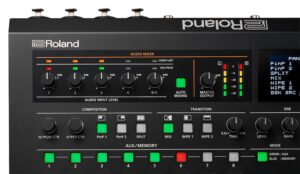 So, for example, you could designate the pastor’s mic with a weight of 100%, and the other inputs a weight of 60%. When the pastor speaks, all other inputs would get lowered in volume, and raised back up when the pastor is done. Latency (the delay from input to output) of the V-60HD is stated as being two frames or less, according to Roland.
So, for example, you could designate the pastor’s mic with a weight of 100%, and the other inputs a weight of 60%. When the pastor speaks, all other inputs would get lowered in volume, and raised back up when the pastor is done. Latency (the delay from input to output) of the V-60HD is stated as being two frames or less, according to Roland.
Roland indicated that future upgrades will include a camera tally system that works through your camera operator’s smartphone, and a software remote control that will run on a computer.
Last Word
I was impressed with the V-60HD. The quality of the DSK took me by surprise, and the switcher was easy and intuitive to operate. The few areas of improvement that exist would not prevent me from recommending it. For $4,799, you get a very capable package that volunteers would quickly learn to operate.
It’s absolutely worth checking out.
Brand: Roland
Model: V-60HD
Pricing: SSP (suggested sell price) of $4,799 AUD inc GST
Product Info: proav.roland.com
Distributor: www.roland.com.au
This article appeared in the print edition of CX Magazine March 2018, pp.46-51. CX Magazine is Australia and New Zealand’s only publication dedicated to entertainment technology news and issues. Read all editions for free or search our archive www.cxnetwork.com.au
Subscribe
Published monthly since 1991, our famous AV industry magazine is free for download or pay for print. Subscribers also receive CX News, our free weekly email with the latest industry news and jobs.


